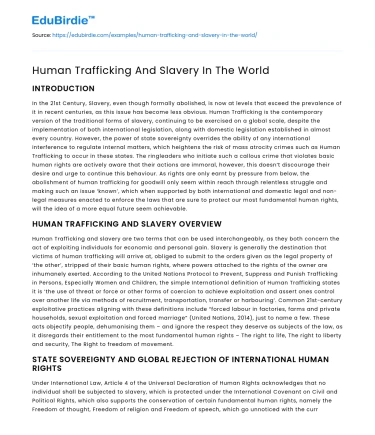INTRODUCTION
In the 21st Century, Slavery, even though formally abolished, is now at levels that exceed the prevalence of it in recent centuries, as this issue has become less obvious. Human Trafficking is the contemporary version of the traditional forms of slavery, continuing to be exercised on a global scale, despite the implementation of both international legislation, along with domestic legislation established in almost every country. However, the power of state sovereignty overrides the ability of any international interference to regulate internal matters, which heightens the risk of mass atrocity crimes such as Human Trafficking to occur in these states. The ringleaders who initiate such a callous crime that violates basic human rights are actively aware that their actions are immoral, however, this doesn’t discourage their desire and urge to continue this behaviour. As rights are only earnt by pressure from below, the abolishment of human trafficking for goodwill only seem within reach through relentless struggle and making such an issue ‘known’, which when supported by both international and domestic legal and non-legal measures enacted to enforce the laws that are sure to protect our most fundamental human rights, will the idea of a more equal future seem achievable.
HUMAN TRAFFICKING AND SLAVERY OVERVIEW
Human Trafficking and slavery are two terms that can be used interchangeably, as they both concern the act of exploiting individuals for economic and personal gain. Slavery is generally the destination that victims of human trafficking will arrive at, obliged to submit to the orders given as the legal property of ‘the other’, stripped of their basic human rights, where powers attached to the rights of the owner are inhumanely exerted. According to the United Nations Protocol to Prevent, Suppress and Punish Trafficking in Persons, Especially Women and Children, the simple International definition of Human Trafficking states it is ‘the use of threat or force or other forms of coercion to achieve exploitation and assert ones control over another life via methods of recruitment, transportation, transfer or harbouring’. Common 21st-century exploitative practices aligning with these definitions include “forced labour in factories, farms and private households, sexual exploitation and forced marriage” (United Nations, 2014), just to name a few. These acts objectify people, dehumanising them – and ignore the respect they deserve as subjects of the law, as it disregards their entitlement to the most fundamental human rights – The right to life, The right to liberty and security, The Right to freedom of movement.
Save your time!
We can take care of your essay
- Proper editing and formatting
- Free revision, title page, and bibliography
- Flexible prices and money-back guarantee
STATE SOVEREIGNTY AND GLOBAL REJECTION OF INTERNATIONAL HUMAN RIGHTS
Under International Law, Article 4 of the Universal Declaration of Human Rights acknowledges that no individual shall be subjected to slavery, which is protected under the International Covenant on Civil and Political Rights, which also supports the conservation of certain fundamental human rights, namely the Freedom of thought, Freedom of religion and Freedom of speech, which go unnoticed with the current presence of global Slavery and Human Trafficking. These international instruments were the basis for contemporary conventions and assisted efforts to combat Human Trafficking.
Despite approximately 27 million people worldwide currently being held as slaves, the enormity of the issue makes it hard to police and enforce, especially considering operations are usually underground.
Compliance of International Law becomes an issue, however, as State Sovereignty allows a state, at its discretion, to make laws within its jurisdiction without external interference, as “no other person, group or state can tell a sovereign entity what to do with its land and/or people” – as protected under UN Charter Article 2. With this in mind, citizens of sovereign states do not have access to the International Human Rights Framework as these states are deemed unrecognised, lacking UN membership – meaning the right to voice any Human Rights violations to the United Nations Human Rights Commission is difficult.
Therefore, the recognition, protection and enforcement of Human Rights rely heavily on the will of sovereign states to enact appropriate legislation, based on International Law; with the integration of ‘Hard Law’ being an effective enforcement strategy for the protection of International Human Rights. This includes Conventions and treaties into domestic legislation, which when ratified, create legally binding obligations within sovereign states. Although there is an array of options presented for sovereign states to acknowledge International Human Rights, states can ignore certain Human Rights if it is not in their best interest, reinforcing that non-UN membership states are more likely committing crimes against humanity, through which Human Trafficking and Slavery falls under.
INTERNATIONAL RESPONSE
Aims of eradicating Slavery dates back to the 19th Century. In 1926, the League of Nations adopted a treaty, namely the Slavery Convention 1926, which accelerated the abolishment of Slavery worldwide after the mass atrocities of WW1, by the pressure of creating obligations within states to label slavery as a crime. The criminalisation of slavery is also supported in the ‘1956 Supplementary Convention on the Abolition of Slavery’. Both of these international responses reinforced that “there is no consensual slavery under International Law” (Fernanda Perez Solla SPDISCUSSIONPAP, 2009). The Universal Declaration of Human Rights (1948) and the International Covenant on Civil and Political Rights (1966) also support anti-trafficking movements and has inspired International Law’s most recent efforts to prohibit and prosecute Human Trafficking offences through various conventions and Treaties. These recent international instruments include the “United Nations Convention against Transnational Organised Crime’ and its two supplementary protocols: the United Nations Protocol to Prevent, Suppress and Punish Trafficking in Persons, Especially Women and Children, and the United Nations Protocol against the Smuggling of Migrants by Land, Sea and Air” (King, n.d.).






 Stuck on your essay?
Stuck on your essay?

